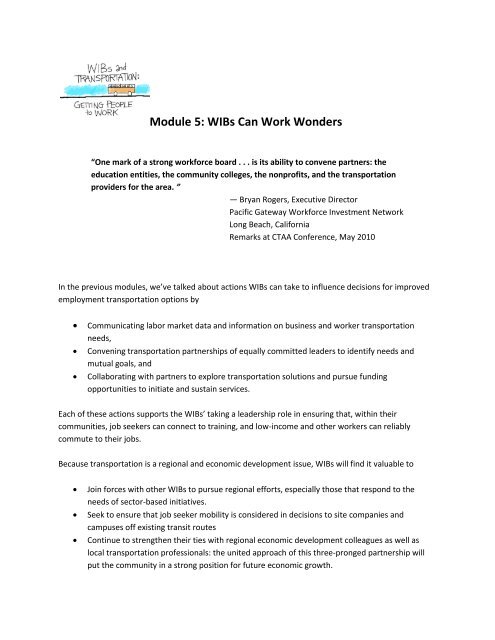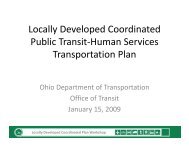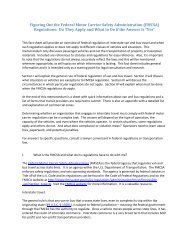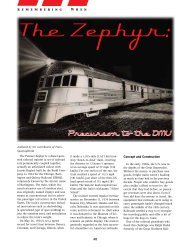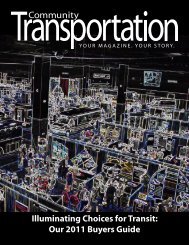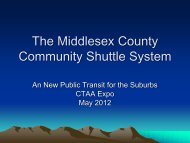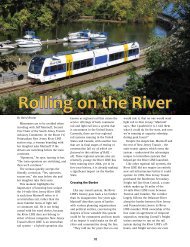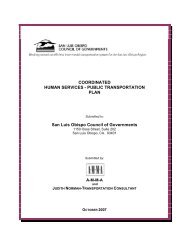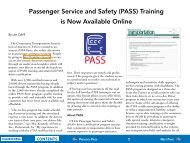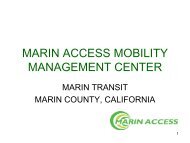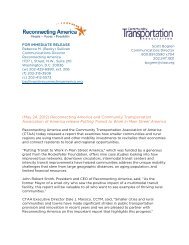Module 5: WIBs Can Work Wonders
Module 5: WIBs Can Work Wonders
Module 5: WIBs Can Work Wonders
You also want an ePaper? Increase the reach of your titles
YUMPU automatically turns print PDFs into web optimized ePapers that Google loves.
<strong>Module</strong> 5: <strong>WIBs</strong> <strong>Can</strong> <strong>Work</strong> <strong>Wonders</strong><br />
“One mark of a strong workforce board . . . is its ability to convene partners: the<br />
education entities, the community colleges, the nonprofits, and the transportation<br />
providers for the area. ”<br />
— Bryan Rogers, Executive Director<br />
Pacific Gateway <strong>Work</strong>force Investment Network<br />
Long Beach, California<br />
Remarks at CTAA Conference, May 2010<br />
In the previous modules, we’ve talked about actions <strong>WIBs</strong> can take to influence decisions for improved<br />
employment transportation options by<br />
� Communicating labor market data and information on business and worker transportation<br />
needs,<br />
� Convening transportation partnerships of equally committed leaders to identify needs and<br />
mutual goals, and<br />
� Collaborating with partners to explore transportation solutions and pursue funding<br />
opportunities to initiate and sustain services.<br />
Each of these actions supports the <strong>WIBs</strong>’ taking a leadership role in ensuring that, within their<br />
communities, job seekers can connect to training, and low-income and other workers can reliably<br />
commute to their jobs.<br />
Because transportation is a regional and economic development issue, <strong>WIBs</strong> will find it valuable to<br />
� Join forces with other <strong>WIBs</strong> to pursue regional efforts, especially those that respond to the<br />
needs of sector-based initiatives.<br />
� Seek to ensure that job seeker mobility is considered in decisions to site companies and<br />
campuses off existing transit routes<br />
� Continue to strengthen their ties with regional economic development colleagues as well as<br />
local transportation professionals: the united approach of this three-pronged partnership will<br />
put the community in a strong position for future economic growth.
Finally, within their own network, <strong>WIBs</strong> can take actions to help One-Stops manage customer<br />
transportation challenges, by encouraging their One-Stop workforce directors and staff to facilitate<br />
transportation solutions for business and job-seeking customers. Here are a few of the opportunities<br />
employment and training agencies might pursue. They could<br />
� Take advantage of cross-marketing opportunities: For example, information about available jobs<br />
can be posted on transit vehicles serving those job routes and throughout the transit network,<br />
just as transit options are promoted in conjunction with job announcements and to customers<br />
of the public workforce system.<br />
� Invite transportation partners to speak at a short in-service training so One-Stop staff know<br />
what transportation services are available for their customers.<br />
� Develop a “transportation center” bulletin board within its customer resource area where<br />
transportation and ridesharing information can be posted.<br />
They could also<br />
� Encourage staff to discuss transportation with each customer during intake and assessment, to<br />
begin meeting transportation challenges before they become a barrier to a job or training<br />
opportunity.<br />
� Encourage business service representatives to inquire about any transportation challenges<br />
employers or their employees are experiencing<br />
� Request One-Stop Career Center staff to collect data on job-seekers’ mobility gaps and share it<br />
with WIB members, so they can feed that information into transportation plans for expanded<br />
services<br />
On both a local and regional level, more and more <strong>WIBs</strong> are recognizing the vital role transportation<br />
plays in economic and workforce development. Community decisions regarding the location of new and<br />
expanding businesses and training sites all impact the ability of individuals to access these opportunities.<br />
In becoming a part of efforts to create transportation strategies, <strong>WIBs</strong> will reap dividends from their<br />
investment of time, resources, and leadership.<br />
Exercises<br />
Continue the good work you have begun with transportation and other partners in your community<br />
through the following exercises:<br />
Exercise 1: Have a discussion within your workforce board about steps you would like to encourage your<br />
One Stop service providers to take in assisting job-seeking and business customers with transportation<br />
issues. Be sure to identify those that respond to the greatest needs you have uncovered. For example,<br />
the most effective action might be to ensure WIA participants know about all the available
transportation resources in the community. For businesses, it might be ensuring they are familiar with<br />
how the Commuter Tax Benefit could help both them and their employees.<br />
Exercise 2: Review the tool provided with this module to assist One Stop staff in collecting data on<br />
unmet transportation needs. Talk with your One Stop executive staff to see how this tool could be<br />
included in daily activities at the One Stop; for example, would it be most time-efficient to create an<br />
easy-to-use on-line survey tool, which allows the results to be automatically collated and then shared<br />
with community transportation professionals?<br />
Exercise 3: Review the U.S. Department of Labor’s Training and Employment Notice No. 21-11,<br />
published January 3, 2012, “Strategies to Meet One-Stop Career Centers’ Business and Job-Seeker<br />
Customer Needs for Employment-Related Transportation Services”<br />
(http://wdr.doleta.gov/directives/corr_doc.cfm?DOCN=6293) for additional actions you can take within<br />
your WIB and One Stop. Record those potential actions.<br />
Thank you for joining us for the <strong>WIBs</strong> and Transportation: Getting People to <strong>Work</strong> training. We hope<br />
that, through this training, you were able to implement some practical steps that will increase the<br />
success of your WIA participants, other job seekers, and workers throughout your community. Please<br />
contact the Joblinks staff at any point to inquire about additional information or for assistance in<br />
improving employment transportation options in your region.


